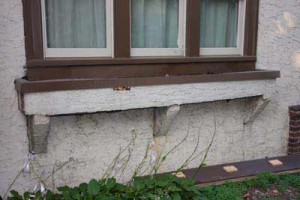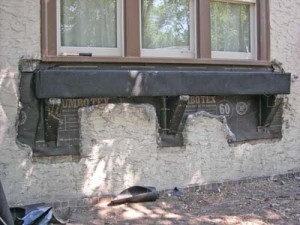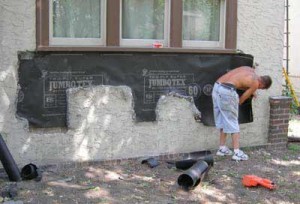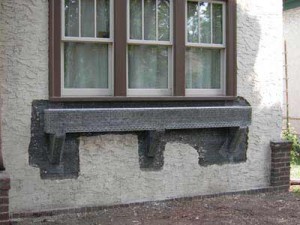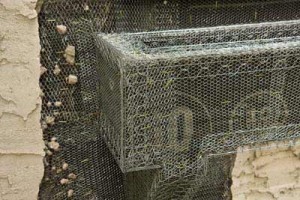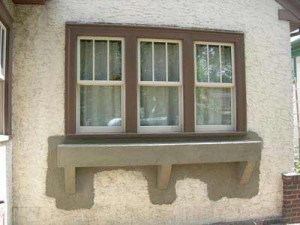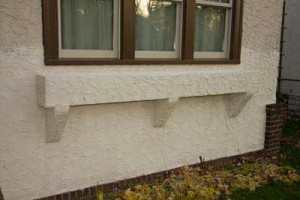Small Home Gazette, Fall 2008
Rebuilding a Stucco Window Box
If you, like me, look at bungalows when traveling outside the Twin Cities, you’ve probably noticed regional differences. For example, the classic Chicago bungalow is built of brick with the front porch tucked under the roof to one side. California bungalows are fanciful; have wide open porches; and are sided with wood.
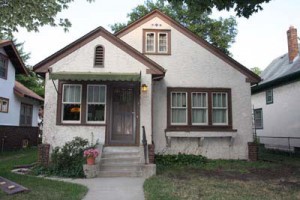 Here in the Twin Cites, typical bungalows are modest, have enclosed front porches, and are often sided with stucco. And many of those stucco bungalows have a rare feature: a stucco window box. I’ve observed bungalows in many parts of the country, and I don’t recall seeing a stucco window box anywhere but here.
Here in the Twin Cites, typical bungalows are modest, have enclosed front porches, and are often sided with stucco. And many of those stucco bungalows have a rare feature: a stucco window box. I’ve observed bungalows in many parts of the country, and I don’t recall seeing a stucco window box anywhere but here.
As an unusual—perhaps unique—feature of our bungalows, they deserve to be preserved. And though they’ve held up well, especially for an architectural appendage, most of them need help.
Dampness and Decay
Most homeowners leave their window box filled with dirt year-round. Though boxes were originally fitted with galvanized steel liners with drain holes, the presence of constant moisture in the dirt will eventually rust it. In addition, freezing earth is subject to frost heaves. The earth in your window box will not only heave up, but out as well, and slowly but surely break it.
Soon after purchasing my bungalow more than a decade ago, I dug the prehistoric dirt out of its window box. I found no dinosaur bones, but plenty of damage. The bottom of the metal liner had long since rusted away, leaving the dirt directly in contact with the wood frame that supported the stucco exterior. The wood had also decayed—badly. In fact, some boards were held together with a 1945 Minnesota license plate, giving a clue as to how long the window box had been in trouble.
Taking the Leap
It’s a testament to the quality of my bungalow’s construction that the window box didn’t fall off before I got around to having it replaced this fall. Why, you may ask, spend thousands on such a repair now, when housing values have plummeted? For the same reasons one would do it during a boom time: to prevent further damage (I feared the rot would migrate into my home’s walls), to improve my home’s appearance, and to invest in its future. I also thought of the project as my personal economic stimulation package. Payment would go directly into the pockets of local craftspeople.
The craftspeople I chose were Donnelly Brothers Stucco, a family-owned business run by four brothers. (Donnelly Brothers Stucco is not to be confused with Donnelly Stucco or Steve Donnelly Stucco, companies that are owned by other family members.) Donnelly Brothers Stucco specializes in residential stucco, and has worked on thousands of vintage bungalows since it was founded in 1987.
I was impressed with Donnelly Brothers Stucco because they showed genuine enthusiasm for old homes and didn’t bat an eye when I said I wanted to replace my window box. Some contractors would have urged me to simply chop the box off and wrap the house in vinyl to hide the scar.

Two examples of window boxes on other Minneapolis bungalows that were rebuilt by Donnelly Brothers Stucco.
John Donnelly took me for a ride around south Minneapolis one evening this summer and pointed out some stucco boxes they’d replaced. They were beautiful. If I hadn’t known they were new, I surely would have assumed they were original.
Deconstruction
Much to my surprise, my old window box didn’t disintegrate; it came off in intact sections. This was despite all the wood rot and an edge-to-edge vertical crack in the center of the stucco, which a previous owner had stabilized with a metal bar and screws. Though the crack was deep, the box was still structurally sound because of the underlying metal mesh, into which the wet stucco had been pressed. The box was, in essence, reinforced concrete.
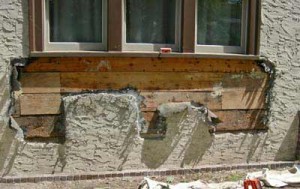
Once the window box was removed, the walls’ substructure was revealed. Two areas of rotted boards were patched.
With the box and three supporting brackets removed, workers found a few rotted siding boards. Thankfully, the wall’s internal structure hadn’t been damaged. I attribute this to dense, old-growth lumber.
With the box removed, one could clearly see the layers of original stucco pressed into the honeycomb-like galvanized metal lath. Though the house is 82 years old, the stucco is in excellent shape. (Donnelly said the random hairline cracks do no harm.) In fact, John Donnelly invited me to take a hammer to the stucco wall just below where the window box had been. Needless to say I was hesitant, as I assumed the material there was weak and loose as a result of the box’s demolition. It wasn’t. After John demonstrated, I took the hammer and delivered a series of hard, swinging blows to the stucco. Nothing chipped; nothing moved. Try that on a wood- or vinyl-sided house.
John Donnelly told of touring neighborhoods in Coon Rapids and Fridley after a tornado tore through them in 1965. “A lot of wood frame houses were destroyed, and I saw a brick house where the four walls had fallen flat away from each other,” John said. “But there was a row of stucco houses that were still standing. The roofs had been lifted and set back down crooked, but with a quarter inch of metal lath and 15,000 to 20,000 pounds of mud on them, they’re not gonna budge.”
Reconstruction
With the old window box gone, workers began building the new one. John had offered to alter the design somewhat by adding details such as raised or recessed ridges or more sculpted supporting brackets. I finally decided, however, to have the box reproduced to match the original, with its coarse, bold trowel pattern.
Actually, I didn’t have it reproduced exactly. I asked to have the bottom left off the window box. I explained that I planned to lay narrow cedar boards lengthwise inside the box, on top of the three brackets. Individual, removable planters could then be set inside the box, resting on the boards. This arrangement would prevent moisture from remaining inside the window box. Water would either go into the removable planters or fall through to the ground below. No moisture, no freezing, no slow destruction of the box.
At first the Donnellys were hesitant to vary from the traditional window box design. They had always faithfully reproduced what they removed, right down to the galvanized metal liner with drain holes. Frankly I wasn’t entirely confident of my plan, either—I was reluctant to try to invent a better mousetrap, as everyone knows the classic mousetrap endures for a reason. But the Donnellys thought about the bottomless window box, discussed it with other tradesmen, and ultimately decided the design made sense. In fact, they say they plan to offer the bottomless box to other customers as an option.
Once the design was agreed upon, construction proceeded quickly over the course of a few days. Workers built the wood frame, wrapped it in tarpaper, and applied an inch-deep wire “skeleton” over the box and brackets, inside and out. It had a sculptural quality to it, actually quite beautiful. Next came two layers of gray cement—the scratch coat and base coat. A week of drying, then the background coat and final stucco coat, which was troweled in a texture to match the rest of my house. Before long, I had a bright new window box. So bright, in fact, that it doesn’t match the rest of my vintage, weathered stucco. Donnelly assured me that the new box would darken in color over the course of a year or so and eventually be difficult to distinguish from the original stucco.
Recommendations
- If you’ve got a stucco window box, I strongly recommend that you not put dirt in it. Moisture is an old home’s primary enemy, especially trapped moisture. Individual planters or flowerpots are easy to remove and replace, and will ensure less moisture seeps into your home’s innards.
- If your window box is in good shape but the metal liner has corroded, you can get a new one custom built. Two local sources are Architectural Sheet Metal in Bloomington (952-881-7497) and Sheridan Sheet Metal in north Minneapolis (763-537-3686). If there’s decay in the box’s wood substructure, however, be sure to repair it before putting in a new liner. Hiding such damage won’t stop its progression.
- If your window box has deteriorated to the point of no return, consider having it replaced by a reputable company. Ask about the training of the business’s work crews. Ask if they use subcontractors. Get recommendations. Look at other work they’ve done. Replacing a window box will cost $4,000 to $5,000 dollars or more. Having a fresh coat of stucco put on the entire exterior of a typical bungalow will generally cost between $7,000 and $10,000, not including window box reconstruction. And there’s an extra cost if paint must be sandblasted off first.
- Some bungalows, especially those built in the late 1920s or early 1930s in Spanish or Mediterranean style, have wrought-iron window boxes with wood or metal planters that slip inside. These have the same advantages as a bottomless stucco box: Water drains through and won’t get trapped against the house. I’ve also seen wood boxes on local stucco houses, but they may have been added after the original stucco box was removed.
- One could always remove a decayed stucco box and replace it with a wrought iron or wood version. But do your research first—the costs of having the stucco patched and buying and installing an iron or wood box could easily equal or exceed the cost of simply rebuilding the stucco box.
Want to See More?
To see the photos in this article—and more—in full color, visit “Rebuilding a Stucco Window Box”.









